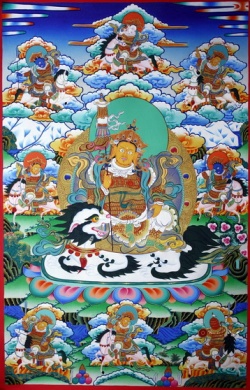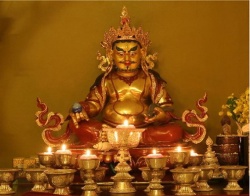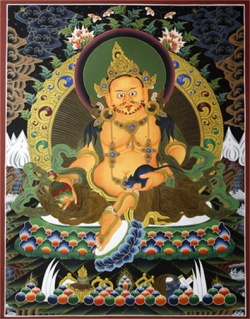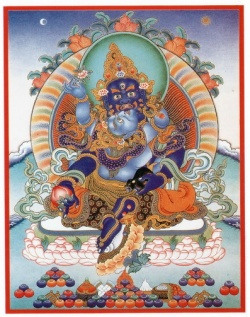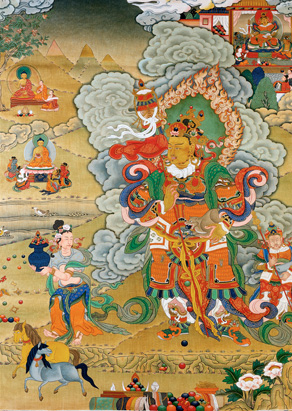Vaiśravaṇa
Vaiśravaṇa (Sanskrit वैश्रवण) or Vessavaṇa (Pāli वेस्सवण, Sinhala වෛශ්රවණ) also known as Namtösé in Tibet and Bishamonten in Japan is the name of the chief of the Four Heavenly Kings and an important figure in Buddhism.
Names
Vaishravana (Skt. Vaiśravaṇa; Tib. རྣམ་ཐོས་སྲས་, Namtösé; Wyl. rnam thos sras; Eng. 'Son of He who has Heard Many Things') — one of the Four Great Kings. Guardian King of the North and leader of the yakshas. Wearing golden armour, Vaishravana protected the gods from the asuras (demi-gods). Vaishravana now occupies the highest position among the Four Guardian Kings and specifically protects Shakyamuni’s Vinaya teachings, protecting those who practise shila (self-discipline).
Because his breath is harmful he keeps his mouth tightly closed. He confers spiritual and material wealth on practitioners of the Dharma, symbolized by the jewel-producing mongoose in his left hand.
The name Vaiśravaṇa is a vṛddhi derivative (used, e.g., for patronymics) of the Sanskrit proper name Viśravaṇa from the root vi-śru "hear distinctly", (passive) "become famous". The name Vaiśravaṇa is derived from the Sanskrit viśravaṇa which means "son of Vishrava", a usual epithet of the Hindu god Kubera. Vaiśravaṇa is also known as Kubera (Sanskrit) or Kuvera (Pāli), and as Jambhala (Sanskrit).
Other names include:
- 多聞天 (simplified characters: 多闻天): Chinese Duō Wén Tiān, Korean Damuncheon (다문천), Japanese Tamonten, Vietnamese Đa Văn Thiên. The characters mean "Much hearing god" or "Deity who hears much".
- 毘沙門天: Chinese Píshāmén Tiān, Korean Bisamuncheon (비사문천), Japanese Bishamonten, Vietnamese Tỳ Sa Môn Thiên. This is a representation of the sound of the Sanskrit name in Chinese (Vaiśravaṇ → Pishamen) plus the character for "heaven" or "god".
- Tibetan: རྣམ་ཐོས་སྲས (rnam.thos.sras Namthöse)
- Mongolian: (Баян) Намсрай (Bayan) Namsrai
- Thai: ท้าวกุเวร or ท้าวเวสสุวรรณ (Thao Kuwen or Thao Vessuwan)
- Tamil: Vaicciravanan
- Filipino: Bathala
Characteristics
The character of Vaiśravaṇa is founded upon the Hindu deity Kubera, but although the Buddhist and Hindu deities share some characteristics and epithets, each of them has different functions and associated myths. Although brought into East Asia as a Buddhist deity, Vaiśravaṇa has become a character in folk religion and has acquired an identity that is partially independent of the Buddhist tradition (cf. the similar treatment of Kuan Yin and Yama).
Vaiśravaṇa is the guardian of the northern direction, and his home is in the northern quadrant of the topmost tier of the lower half of Mount Sumeru. He is the leader of all the yakṣas who dwell on the Sumeru's slopes.
He is often portrayed with a yellow face. He carries an umbrella or parasol (chatra) as a symbol of his sovereignty. He is also sometimes displayed with a mongoose, often shown ejecting jewels from its mouth. The mongoose is the enemy of the snake, a symbol of greed or hatred; the ejection of jewels represents generosity.
In Theravāda tradition
In the Pāli scriptures of the Theravāda Buddhist tradition, Vaiśravaṇa is called Vessavaṇa. Vessavaṇa is one of the Cātummahārājāno, or four Great Kings, each of whom rules over a specific direction. Vessavaṇa's realm is the northern quadrant of the world, including the land of Uttarakuru. According to some suttas, he takes his name from a region there called Visāṇa; he also has a city there called Ālakamandā which is a byword for wealth. Vessavaṇa governs the yakkhas – beings with a nature between 'fairy' and 'ogre'.
Vessavaṇa's wife is named Bhuñjatī, and he has five daughters, Latā, Sajjā, Pavarā, Acchimatī, and Sutā. He has a nephew called Puṇṇaka, a yakkha, husband of the nāga woman Irandatī. He has a chariot called Nārīvāhana. His weapon was the gadāvudha (Sanskrit: gadāyudha), but he only used it before he became a follower of the Buddha.
Vessavaṇa has the name "Kuvera" from a name he had from a past life as a rich Brahmin mill-owner, who gave all the produce of one of his seven mills to charity, and provided alms to the needy for 20,000 years. He was reborn in the Cātummahārājikā heaven as a result of this good kamma.
As with all the Buddhist deities, Vessavaṇa is properly the name of an office (filled for life) rather than a permanent individual. Each Vessavaṇa is mortal, and when he dies, he will be replaced by a new Vessavaṇa. Like other beings of the Cātummahārājika world, his lifespan is 90,000 years (other sources say nine million years). Vessavaṇa has the authority to grant the yakkhas particular areas (e.g., a lake) to protect, and these are usually assigned at the beginning of a Vessavaṇa's reign.
When the Buddha was born, Vessavaṇa became his follower, and eventually attained the stage of sotāpanna (Sanskrit: srotaāpanna, one who has only seven more lives before enlightenment). He often brought the Buddha and his followers messages from the gods and other humans, and protected them. He presented to the Buddha the Āṭānāṭā verses, which Buddhists meditating in the forest could use to ward off the attacks of wild yakkhas or other supernatural beings who do not have faith in the Buddha. These verses are an early form of paritta chanting.
Bimbisāra, King of Magadha, after his death was reborn as a yakkha called Janavasabha in the retinue of Vessavaṇa.
In the early years of Buddhism, Vessavaṇa was worshipped at trees dedicated to him as shrines. Some people appealed to him to grant them children.
In Japan
In Japan, Bishamonten (毘沙門天), or just Bishamon (毘沙門) is thought of as an armor-clad god of warfare or warriors and a punisher of evildoers – a view that is at odds with the more pacific Buddhist king described above. Bishamon is portrayed holding a spear in one hand and a small pagoda in the other hand, the latter symbolizing the divine treasure house, whose contents he both guards and gives away. In Japanese folklore, he is one of the Japanese Seven Gods of Fortune.
Bishamon is also called Tamonten (多聞天), meaning "listening to many teachings" because he is seen as the guardian of the places where Buddha preaches. He is believed to live halfway down Mount Sumeru.
In Tibet
In Tibet, Vaiśravaṇa is considered a worldly dharmapāla or protector of the Dharma, a member of the retinue of Ratnasambhava. He is also known as the King of the North. As guardian of the north, he is often depicted on temple murals outside the main door. He is also thought of as a god of wealth. As such, Vaiśravaṇa is sometimes portrayed carrying a citron, the fruit of the jambhara tree, a pun on another name of his, Jambhala (Skt. jambhala; Tibetan ཛམ་བྷ་ལ་ and pronounced Jambhala or Zambala). The fruit helps distinguish him iconically from depictions of Kuvera. He is sometimes represented as corpulent and covered with jewels. When shown seated, his right foot is generally pendant and supported by a lotus-flower on which is a conch shell. His mount is a snow lion.
Nam Te Se. (རྣམ་ཐོས་སྲས་ or རྣམ་སྲས་) is not Dzambala. Nam Te is the king, and Dzambala is one of his ranking ministers. Nam Te Se has eight ranks, and Dzambala is one of these ranks.
Tibetan Buddhists consider Jambhala's sentiment regarding wealth to be providing freedom by way of bestowing prosperity, so that one may focus on the path or spirituality rather than on the materiality and temporality of that wealth.
In Thailand
In Thailand, he resolves the dispute that arose in the legend of Nang Ai and Phadaeng.
In popular culture
- In the video game series Onimusha (specifically Onimusha: Warlords), a Bishamon statue is seen in the game. The Bishamon Sword is also the ultimate weapon in the game.
- Bishamon is the name of a video game character in the Darkstalkers series.
- In Atlus' video game series Megami Tensei, Bishamon is categorized into Kishin clan which includes the protectors of various pantheons. His character model is based on Japanese beliefs of Bishamon.
- In Samurai Sentai Shinkenger, Doukoku Chimatsuri, leader of the Gedoushu and the show's main antagonist, is modeled after Vaiśravaṇa.
- In the Touhou game Undefined Fantastic Object, the character Shou Toramaru is introduced. Shou is a tiger Youkai who holds the position of a disciple/Avatar of Vaiśravaṇa (or Bishamonten, depending on the translation). Shou herself evokes the image of Bishamonten by carrying a spear and a "Jeweled Pagoda" which allows her to channel the divine power of Vaiśravaṇa .
Warlord Uesugi Kenshin was a follower of Bishamonten. His soldiers and officers thought of him as the avatar of Bishamonten
- In the Japanese anime Toradora!, Yasuko Takasu, mother of the main protagonist works at a hostess bar named "Bishamontengoku" which when translated turns out as Vaiśravaṇa's Heaven.
- In another anime, Noragami, Bishamon is depicted as a female war god with a grudge against the series' main character, Yato.
Source
Vaishravana (Skt. Vaiśravaṇa; Tib. རྣམ་ཐོས་སྲས་, Namtösé; Wyl. rnam thos sras; Eng. 'Son of He who has Heard Many Things') — one of the Four Great Kings. Guardian King of the North and leader of the yakshas.
Wearing golden armour, Vaishravana protected the gods from the asuras (demi-gods).
Vaishravana now occupies the highest position among the Four Guardian Kings and specifically protects Shakyamuni’s Vinaya teachings, protecting those who practice shila (self-discipline).
Because his breath is harmful he keeps his mouth tightly closed. He confers spiritual and material wealth on practitioners of the Dharma, symbolized by the jewel-producing mongoose in his left hand.
Further Reading
- Crystal Mirror, volume VI, Dharma Publishing 1984
One of the four maharaja deva graudians of the first or lowest devaloka on its four sides. Vaisravana guards the north.
Source
Vaishravana, the Lord of Wealth, is the Buddhist counterpart of Kubera, the Brahmanical god of wealth and like him he presides over the domain of riches. As a Lokapala or Guardian King, Vaishravana looks after the Northern region and the Mount Sumeru, the centre of the universe. His abode is Alaka in the Himalayas, abounding in wealth and magnificence, where he is attended upon by Yakshas and Kinnaras. Vaishravana is also the king of Yakshas.
The body of Vaishravana is golden yellow in color and he has a stern expression. His right hand holds a banner of victory, while the left arm holds a mongoose, an animal associated with good fortune. The mongoose is shown vomiting jewels symbolizing the boon of this Lord of wealth. Vaishravana in addition is also the Guardian deity of the north direction. Thus his image is often placed on the outer walls of monasteries and temples along with the guardians of the other three directions. This is believed to be a safeguard against harmful influences which violate the sanctity of the sanctum inside.
In the present form he is shown seated on a roaring red lion, placed on a lotus base. His is a golden yellow complexion. Vaishravana has two hands, the right hand in holding a lemon and the left one a jewel–spitting mongoose, establishing him as the deity of wealth. A jewel offering has been shown in front of him. Vaishravana is wearing a five-pronged crown, symbolic of the Five Transcendental Buddhas. His hair is upswept in a knot with a jewel on it. His open eyes, frowning eyebrows, upturned lips, moustache and a beard are all painted. He wears a long and flowing scarf. The scarf rounds behind the head in the shape of a Prabhamandala (halo). The ornaments of the deity include necklaces, armlets and bracelets. Vaishravana has a snake around his body. In spite of adornment he is bare to the waist, and his legs are covered by a dhoti (skirt).
In Tibet, he has been one of the primary protectors of the Gelugpa Sect since the fourteenth century. Serving as the Protector of the middle scope of the Lamrim. In his capacity as one of the Four Directional Guardians, he is often depicted on the outer walls of monasteries and temples, to safeguard against harmful interferences.
His spiritual energy in the form of sound that helps to transform the mind (Mantra):
OM VAISHRAVANA YE SOHA
There is a special ceremony in Tibet for imploring Vaishravana for riches, which is called Yanyung, and he plays an important part in the Tantras, in sorcery and exorcism. Vaishravana has two main aspects that of a warrior protector and that of deity of wealth. Here he has been shown as the deity of wealth. In southern Buddhism, particularly in the Indian sub-continent, Vaishravana is known as Jambhala, because he also carries a Jambhara (lemon) in one of his hands. Though he holds different attributes and forms e.g., a sword, a banner, lemon and flat vessel etc., his most common attribute or insignia is a mongoose (Nakula), often vomiting jewels and in all descriptions he is said to be fat and pot-bellied in appearance. His female counter part is Vasundhara, the goddess of wealth and prosperity.
